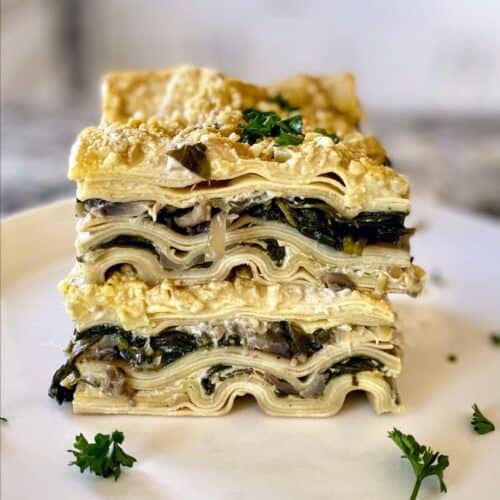Vegetable lasagna with white sauce is a creamy, delicious alternative to the traditional red sauce version. It contains layers of tender pasta, sautéed vegetables, rich béchamel, and gooey melted cheese. The smooth, velvety white sauce blends perfectly with fresh ingredients, making every bite comforting and flavorful.
This dish is perfect for vegetarians or anyone craving a lighter, creamier take on classic lasagna. The combination of zucchini, spinach, mushrooms, and bell peppers adds vibrant colors and textures.
Unlike tomato-based lasagna, vegetable lasagna with white sauce has a delicate, savory taste that enhances the natural flavors of the ingredients.
It is also easy to customize with different vegetables, cheeses, and herbs. Whether you are making it for a family dinner or a special occasion, this recipe is a guaranteed crowd-pleaser.
It is simple to prepare ahead of time and reheat, making it a convenient and satisfying meal option. Therefore, this content delves into all information you need to know about vegetable lasagna with white sauce.
Ingredients and Substitutions

Vegetable lasagna with white sauce requires fresh ingredients that blend together for a creamy, flavorful dish. Choosing the right vegetables, cheese, and sauce components ensures a perfect balance of taste and texture.
Lasagna Layers
Lasagna Noodles: The foundation of vegetable lasagna with white sauce starts with lasagna noodles. Regular, whole wheat, or oven-ready noodles work well. Boiling noodles until al dente prevents mushy layers. Gluten-free noodles are a great option for those avoiding wheat.
Fresh vegetables: Fresh vegetables add flavor and color. Zucchini, spinach, mushrooms, and bell peppers create a hearty texture. Carrots, eggplant, and broccoli are excellent additions. Roasting or sautéing vegetables before layering enhances their taste. Avoid using watery vegetables like tomatoes to prevent a soggy dish.
Cheese: Cheese brings richness and depth. Mozzarella provides stretch, ricotta offers creaminess, and parmesan adds a nutty flavor. Cottage cheese is a lighter alternative to ricotta. For extra indulgence, provolone or gouda can be used.
White Sauce (Béchamel Sauce)
The white sauce is the heart of the dish. It starts with butter, flour, and milk. A smooth, lump-free consistency ensures a creamy texture. Adding a pinch of nutmeg enhances the flavor. Garlic, black pepper, and Italian herbs can be included for extra depth.
For a richer sauce, heavy cream can replace some milk. If a lighter version is preferred, almond or oat milk works well. Cheese can be added for a thicker, more flavorful sauce. A combination of parmesan and cheddar creates a creamy, cheesy béchamel.
Substitutions and Dietary Modifications
For a gluten-free version, use gluten-free noodles and substitute all-purpose flour with cornstarch or rice flour in the sauce. For a dairy-free alternative, replace butter with olive oil and use plant-based milk. Nutritional yeast can replace cheese for a cheesy flavor without dairy.
Vegans can swap ricotta with blended tofu and use vegan cheese. Roasted cashew cream makes an excellent substitute for béchamel sauce. A mixture of almond milk and nutritional yeast provides a creamy, nutty taste.
By carefully selecting ingredients, this dish can be tailored to different dietary needs while maintaining its rich, comforting flavor. The combination of fresh vegetables, creamy white sauce, and melted cheese creates a satisfying, hearty meal.
Read More
How To Make Knorr Vegetable Soup Mix
10 Easy Ground Beef Crock Pot Recipes for Busy Weeknights
Step-by-Step Cooking Instructions
Making vegetable lasagna with white sauce requires simple steps to create a rich, flavorful dish. Preparing each layer correctly ensures a creamy, well-balanced lasagna.
Step 1: Preparing the White Sauce
Start by melting butter in a pan over medium heat. Add flour and whisk continuously to create a smooth paste. Cook for a minute to remove the raw flour taste. Slowly pour in warm milk while whisking to prevent lumps. Stir until the sauce thickens. Season with salt, black pepper, and a pinch of nutmeg.
For extra flavor, add garlic, parmesan, or Italian herbs. If the sauce becomes too thick, add more milk. If it’s too thin, cook it longer. A perfect white sauce should be velvety and coat the back of a spoon. This creamy base enhances the overall taste of vegetable lasagna with white sauce.
Step 2: Cooking the Vegetables
Chop zucchini, spinach, mushrooms, and bell peppers into small pieces. Sauté them in olive oil until they soften and release moisture. Avoid overcooking, as they will continue cooking in the oven. Season with salt, pepper, and dried oregano for extra flavor.
Roasting vegetables instead of sautéing can add a deeper, caramelized taste. If using watery vegetables like zucchini, sprinkle salt and let them sit for a few minutes before cooking. This helps reduce excess moisture and prevents a soggy lasagna.
Step 3: Boiling the Lasagna Noodles
Boil lasagna noodles in salted water until al dente. Drain and lay them flat on a baking sheet to prevent sticking. If using oven-ready noodles, skip this step. They will absorb moisture from the sauce while baking.
Step 4: Layering the Lasagna
Spread a thin layer of white sauce on the bottom of a baking dish. Place lasagna noodles over the sauce. Add a layer of sautéed vegetables, followed by ricotta and mozzarella cheese. Repeat until all ingredients are used. Finish with a top layer of noodles, white sauce, and shredded parmesan.
Step 5: Baking and Serving
Cover with foil and bake at 375°F (190°C) for 30 minutes. Remove foil and bake for another 15 minutes until golden. Let it rest for 10 minutes before slicing.
This method ensures vegetable lasagna with white sauce has the perfect balance of flavors, textures, and creaminess.
Tips for Perfect White Sauce Lasagna

Making vegetable lasagna with white sauce requires careful preparation to achieve the perfect balance of flavors and textures. These tips will help prevent common mistakes and ensure a delicious, creamy dish.
Preventing a Runny or Thick Sauce
White sauce should be smooth and velvety. If it’s too thick, add warm milk gradually while whisking. If it’s too thin, cook it longer until it reaches the right consistency. Avoid adding cold milk, as it can create lumps. A pinch of nutmeg and garlic enhances the sauce’s flavor without overpowering it.
Balancing Vegetables and Cheese
Using too many watery vegetables can make the lasagna soggy. Sauté or roast zucchini, mushrooms, and bell peppers to remove excess moisture. Pat them dry before layering. Cheese should be evenly distributed—too much can make the dish greasy, while too little may result in a dry texture.
Enhancing Flavor with Herbs and Seasonings
Fresh basil, oregano, and thyme add depth to vegetable lasagna with white sauce. A sprinkle of red pepper flakes gives a mild kick. Using a mix of mozzarella, ricotta, and parmesan creates a rich, cheesy taste. If using plant-based alternatives, nutritional yeast and dairy-free cheese provide a similar depth of flavor.
Storing and Reheating
Lasagna tastes even better the next day. Store leftovers in an airtight container in the fridge for up to four days. Reheat in the oven at 350°F (175°C) for 15 minutes or microwave in short intervals to maintain texture. Freezing works well—just thaw overnight before baking.
Serving Suggestions and Variations
Vegetable lasagna with white sauce pairs well with light, flavorful side dishes that balance its creamy texture. A crisp green salad with balsamic vinaigrette adds freshness, while garlic bread provides a crunchy contrast. Roasted asparagus or sautéed green beans make excellent vegetable sides, complementing the dish’s rich flavors. For a heartier meal, serve with a warm bowl of tomato soup or a light broth-based soup.
To make a creative Variations Pesto Infusion, spread a thin layer of basil pesto between the noodles and sauce for an herby kick. For a spicy version, add crushed red pepper flakes or a dash of cayenne to the sauce for subtle heat.
For a cheese Swap, use gouda, provolone, or smoked cheddar for a different depth of flavor. Also, for a single-Serve Portions, make mini lasagnas in ramekins for an elegant presentation.
This dish is easy to customize. Extra protein can be added with tofu, chickpeas, or white beans. Experimenting with different ingredients ensures a unique and delicious meal every time. Whether keeping it classic or adding a twist, this lasagna remains a creamy, satisfying favorite for any occasion.
Conclusion
Vegetable lasagna with white sauce is a comforting, creamy dish that is perfect for any occasion. The combination of tender pasta, sautéed vegetables, rich béchamel, and melted cheese creates a satisfying, well-balanced meal. Unlike traditional red sauce lasagna, this version has a smooth, velvety texture that enhances the natural flavors of the ingredients.
This dish is highly versatile. You can experiment with different vegetables, cheeses, and seasonings to suit your taste. Whether you prefer classic zucchini and spinach or want to try roasted eggplant and caramelized onions, the possibilities are endless. Pesto, spicy seasonings, or alternative cheeses can further enhance its depth of flavor.
It is also a great make-ahead meal. You can refrigerate leftovers for quick meals or freeze portions for later use. Proper layering and sauce consistency ensure that each bite is creamy and flavorful.
Whether you are serving it for a family dinner or a special gathering, this dish is always a hit. Its rich, cheesy layers make it a comforting favorite, while the fresh vegetables add a healthy twist. Once you try this homemade version, it’s sure to become a staple in your kitchen.
